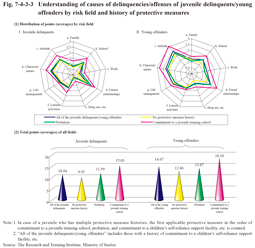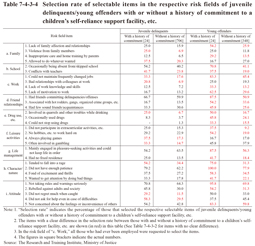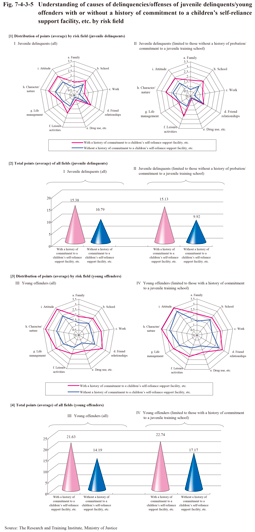2 Understanding of causes by problem field
Factors in delinquencies/offenses can include not only the problem of individual predispositions but also various other problems such as their relationships with people around them and problems and issues in their living environment, etc. In this special survey, we divided possible risk factors in delinquencies/offenses into nine different fields, namely, family, school, work, friend relationships, drug use, etc. (including problematic drinking), leisure activities, life management, character/nature, and attitude, and analyzed the problems that juvenile delinquents/young offenders faced by asking them to select items that they considered to have affected their delinquencies/offenses in each field.
Table 7-4-3-2 shows the rate of each selectable item in the respective fields with juvenile delinquents/young offenders. First, examining the rate of juvenile delinquents revealed that the selection rates of “not taking rules and warnings seriously” (64.5%, attitude), “mainly engaged in pleasure-seeking activities and could not keep life in order” (63.2%, life management), “did not have enough patience” (62.7%, character/nature), “had friends committing delinquencies/offenses” (60.1%, friend relationships), and “being bored and idling time away” (45.2%, leisure activities) were high. With young offenders the items with the highest selection rates were “did not have enough patience” (79.3%, character/nature), “not taking rules and warnings seriously” (71.5%, attitude), “not concerned about the feelings or inconvenience of others” (61.3%, attitude), “recklessly spent money” (60.5%, life management), and “mainly engaged in pleasure-seeking activities and could not keep life in order” (58.3%, life management) in that order. Many juvenile delinquents and young offenders therefore understood the problems concerning their predispositions such as lack of patience or ignoring the rules, life management, and associations with friends affected their delinquencies/offenses. Examining the difference between juvenile delinquents and young offenders revealed that with young offenders their problems became worse than with juvenile delinquents in various fields as the selection rate of drug use/abuse, etc. was high in the field of drug use, etc., that of lack of family affection and poor family relationships was relatively high in the field of family, thus indicating the further influence of family problems, that of difficulty in continued employment and lack of motivation to work was high in the field of work, that of association with delinquent groups, including organized crime groups, etc., was high at over 1/3 in the field of association with friends, indicating the worse quality of their association with delinquent friends, and that of gambling and debt problems was relatively high in the field of leisure activities and life management, thus indicating that their problems in maintaining a work life became difficult with their lifestyle associating with delinquent friends and pleasure-seeking.
Table 7-4-3-2 Selection rate of items in the respective risk fields of juvenile delinquents/young offenders
Fig. 7-4-3-3 [1] shows the sum of the points (shown in averages) of the respective fields calculated by adding one point to the field of each selectable item selected by each survey subject and Fig. 7-4-3-3 [2] the total points of all fields by history of protective measures. The level of the points is considered to reflect the level of problems in the respective fields of their self-understanding. With (all) juvenile delinquents the points were high for the fields of character/nature (2.0), attitude (1.8), association with friends (1.6), school (1.4), and life management (1.3), whereas with (all) young offenders the points were high for the fields of attitude (2.5), character/nature (2.3), association with friends (1.9), life management (1.8), and school (1.5). The points were higher in all fields with young offenders, and the total points (Fig. 7-4-3-3 [2]) also higher with young offenders at approximately 15 points than with juvenile delinquents at approximately 11 points, with a difference of approximately four points (equivalent to approximately four items) in average, thus leading to the assumption that the problems of young offenders grew wider-ranging and severer. Furthermore, by history of protective measures, with both juvenile delinquents and young offenders the total points was the lowest with those without a history of protective measures, followed by those with a history of probation, and then those with a history of commitment to a juvenile training school. However, the total points were higher with young offenders than with juvenile delinquents for every protective measure history category. Their problems generally tended to be wider-ranging over various fields with those whose level of protective measure history were severer or whose ages were higher. Young offenders who committed offenses even after receiving correctional education in juvenile training schools, etc. could be a sign of it.
Fig. 7-4-3-3 Understanding of causes of delinquencies/offenses of juvenile delinquents/young offenders by risk field and history of protective measures
Next, in addition to analysis of the level of protection needs/delinquent tendencies by the categorization of “without a history of protective measures,” “with a history of probation,” and “with a history of commitment to a juvenile training school,” a comparison is made between those with and without commitment to a children’s self-reliance support facility, etc., regardless of a history of other protective measures, in thereby providing analysis from the point of view of the early occurrence of delinquencies (See Fig. 7-2-2-4).
Table 7-4-3-4 shows the selection rate of items in the respective fields given in Table 7-4-3-2, but limited to items with a clear difference in the selection rate between those with and without a history of commitment to a children’s self-reliance support facility, etc. of juvenile delinquents/young offenders with or without the said history. The selection rate was clearly higher with those with a history of commitment to a children’s self-reliance support facility, etc. than with those without the said history for many items in the fields of family, school, work, drug use, etc., leisure activities, character/nature, and attitude with juvenile delinquents and in every field with young offenders.
Table 7-4-3-4 Selection rate of selectable items in the respective risk fields of juvenile delinquents/young offenders with or without a history of commitment to a children’s self-reliance support facility, etc.
Fig. 7-4-3-5 shows the distribution of points by risk field and the total points of all fields of juvenile delinquents/young offenders with or without a history of commitment to a children’s self-reliance support facility, etc.
Fig. 7-4-3-5 Understanding of causes of delinquencies/offenses of juvenile delinquents/young offenders with or without a history of commitment to a children’s self-reliance support facility, etc. by risk field
The average points by field of juvenile delinquents with a history of commitment to a children’s self-reliance support facility, etc. (24 persons) ([1] I in the same figure) was particularly high in the fields of character/nature (2.7) and attitude (2.6), and was higher in these fields and those of family, work, drug use, etc., and leisure activities than that of those without the said history. The average points by field of young offenders with a history of commitment to a children’s self-reliance support facility, etc. (24 persons) ([3] III in the same figure) was particularly high in the fields of friend relationships (2.7), life management (2.6), character/nature (3.3), and attitude (3.3), and was higher in all fields than that of those without the said history.
The total points of juvenile delinquents with a history of commitment to a children’s self-reliance support facility, etc. was high at 15.4, which was higher than that of those without the said history (10.8) ([2] I in the same figure), and the total points of young offenders with the said history 21.6, which was significantly higher than that of those without the said history (14.2) ([4] III in the same figure). This means that the total points of those with a history of commitment to a children’s self-reliance support facility, etc. was higher than that of those without the said history, with the difference being wider with young offenders.
Furthermore, examining the total points of juvenile delinquents with or without a history of commitment to a children’s self-reliance support facility, etc. but limiting them to those without a history of probation or commitment to a juvenile training school ([2] II in the same figure) revealed that the point of those with a history of commitment to a children’s self-reliance support facility, etc. (15 persons) was 15.1, whereas that of those without the said history was 9.9. In addition, examining the total points of young offenders with or without a history of commitment to a children’s self-reliance support facility, etc. but limiting them to those with a history of commitment to a juvenile training school ([4] IV in the same figure) revealed that the total points of those with a history of commitment to a children’s self-reliance support facility, etc. (19 persons) was 22.7, which was remarkably higher than that of those without the said history (17.2).
Juvenile delinquents and young offenders with a history of commitment to a children’s self-reliance support facility, etc. tended to have various problems in a number of fields, and the problems of young offenders tended to be more serious. The problems of those who committed delinquencies early and subsequently repeated delinquencies or offenses tended to be severer and wider-ranging, and with many of those that repeated offenses even after becoming an adult, in particular, had more serious problems and were in high need of appropriate treatment.



